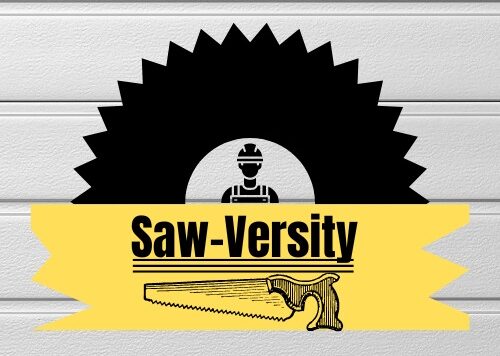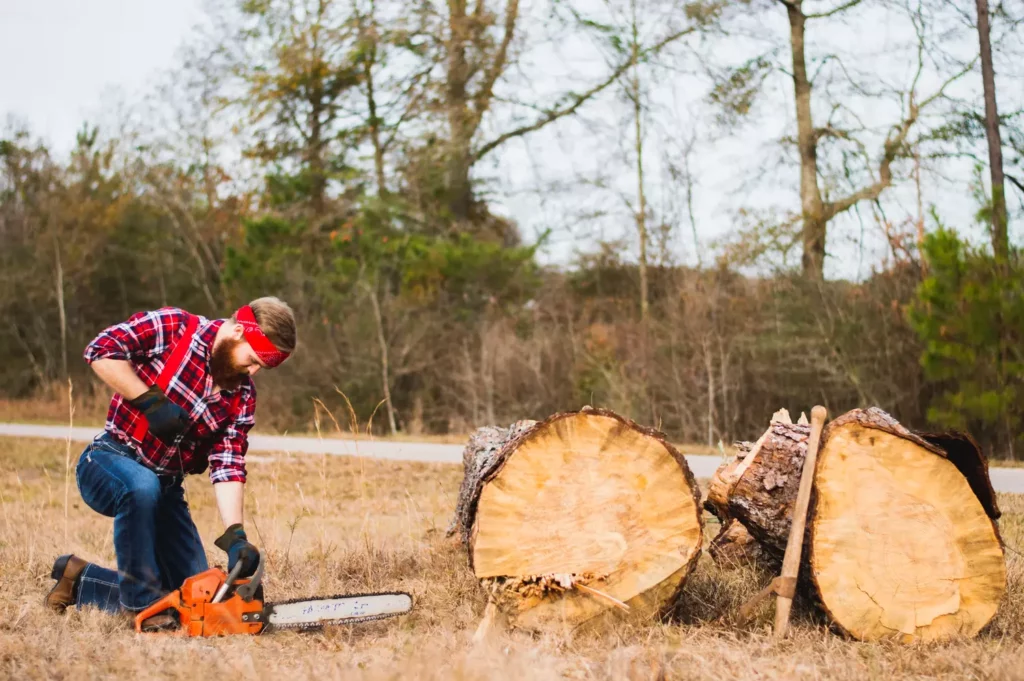Are you a DIY enthusiast looking to tackle some outdoor projects? Or maybe you’re a professional landscaper or logger in need of reliable equipment. Whatever your reason for considering using a chainsaw, it’s important to understand the proper techniques and safety precautions involved. From the anatomy of the tool to advanced cutting techniques, this ultimate guide has everything you need to know about how to use a chainsaw. So grab your personal protective equipment (PPE) and let’s get started!
Why Is It Important To Know How To Use A Chainsaw?
Learning how to use a chainsaw is essential for anyone who plans on using one. Not only can it save you time and money, but it also ensures your safety while operating the chainsaw. A chainsaw is a powerful machine that requires proper handling and knowledge to operate efficiently.
Without proper training, the risk of accidents increases significantly. Chainsaws are responsible for many accidents each year, ranging from minor cuts and bruises to serious injuries or even death in some cases. Knowing how to use a chainsaw correctly will help minimize these risks and keep you safe while working.
Additionally, understanding the different types of chainsaws available is crucial when selecting which one suits your needs. Each model has its strengths and weaknesses based on factors such as power output, blade length, weight distribution, etc.
Knowing how to use a chainsaw properly will not only make your work more efficient but also ensure that you stay safe while doing so.
Different Types Of Chainsaws
When it comes to choosing a chainsaw, there are several types available in the market. The type of chainsaw you choose will depend on your specific needs and requirements.
One of the most common types is the gas-powered chainsaw. They are powerful, versatile, and ideal for heavy-duty tasks like felling large trees. However, they can be noisy, heavy, and require regular maintenance.
Electric chainsaws are another popular option that is suitable for smaller jobs around your yard or garden. These saws are quieter than their gas counterparts and require less maintenance but have limited mobility due to their corded nature.
Cordless electric saws run on rechargeable batteries instead of being plugged into an outlet during use which makes them perfect for small clean-up tasks with minimal noise levels making them ideal for urban environments.
Another type of Chainsaw is pole saws that allow users to reach high branches without having to climb ladders or use other equipment; these tools come in both electric and gas-powered versions.
When selecting a chainsaw it’s important to consider factors such as power source, weight distribution, and intended usage before making any purchase decisions
Safety First
When it comes to using a chainsaw, safety should always be your number one priority. Chainsaws are powerful and dangerous tools that require proper handling and precautions to prevent accidents.
One of the first safety measures you should take is wearing personal protective equipment (PPE). This includes a hard hat, eye and ear protection, gloves, boots with steel-toe caps, and chaps or pants designed for chainsaw use.
Chainsaws also come with built-in safety features such as chain brakes that stop the chain from rotating in case of kickback. Make sure you understand how these features work before operating your saw.
Before starting your chainsaw, make sure the area around you is clear of any obstacles or hazards such as rocks or debris. You should also never operate a chainsaw alone in case an accident occurs.
If you’re new to using a chainsaw or have not used it in a while, consider taking a course on safe operation techniques and maintenance tips. It’s better to be over-prepared than underprepared when it comes to safety.
Personal protective equipment (PPE)
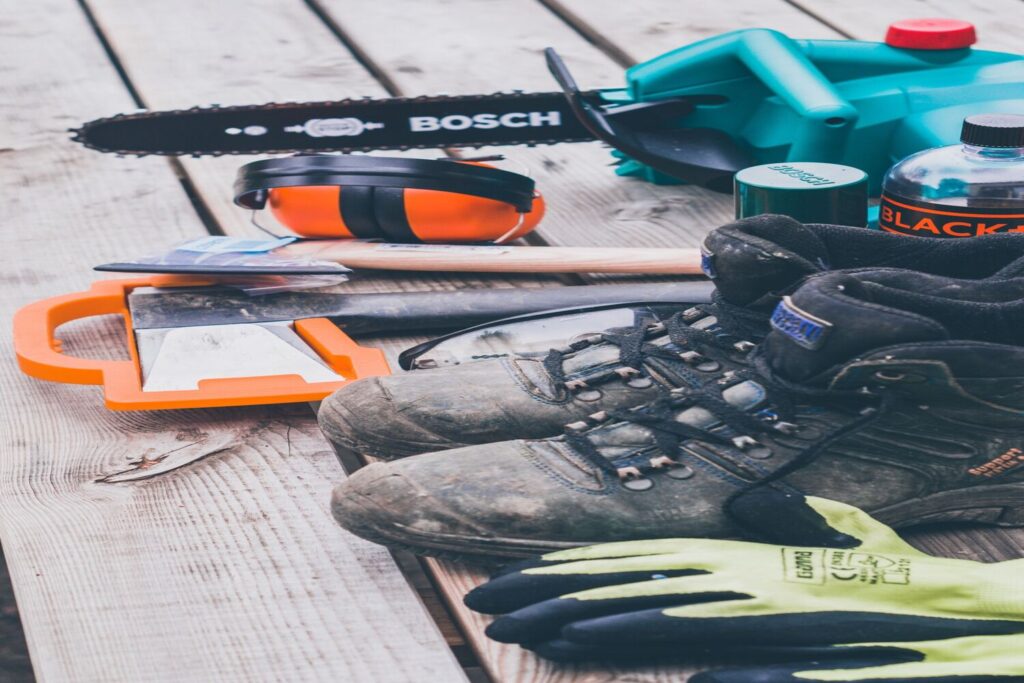
When it comes to using a chainsaw, personal protective equipment (PPE) is not optional. It’s essential for keeping yourself safe and minimizing the risk of injury.
The first piece of PPE you should always wear is a hard hat or helmet with ear protection. This will protect your head from falling branches or debris, as well as reduce noise levels that could cause hearing damage over time.
Next up are safety glasses or goggles to protect your eyes from flying wood chips and sawdust. Make sure they fit snugly to prevent any particles from getting in around the edges.
A face shield can also be added for extra protection if needed, especially when working with larger trees or thicker branches that could kick back toward you.
Gloves with non-slip material on the palms are important for maintaining a grip on the chainsaw handle while preventing blisters and calluses.
Chainsaw chaps made from heavy-duty fabric provide an extra layer of defense against accidental contact with the chainsaw blade, reducing potential injuries significantly.
Sturdy work boots with steel toes will help keep your feet protected from falling objects and sharp debris underfoot.
Investing in proper PPE may seem like an additional expense at first but can save both money and pain in the long run by avoiding unexpected hospital bills!
Chainsaw Safety Features
Chainsaws are powerful tools that can easily cause accidents if they’re not used properly. That’s why safety features are a crucial part of any chainsaw. Chainsaw safety features include:
1. Chain brake: This is a device that stops the chain from rotating in case of kickback or other incidents.
2. Throttle lockout: This feature requires users to engage both hands on the saw before starting it up, which prevents accidental engagement of the throttle.
3. Anti-vibration system: A good anti-vibration system helps reduce fatigue and increases comfort while using a chainsaw.
4. Safety switch/trigger lock: Most modern chainsaws come with this important feature, which ensures that only experienced operators will be able to start and operate the tool safely.
5. Spark arrestor screens: These devices help prevent hot sparks from escaping from your saw’s engine and causing fires in dry conditions.
6. Automatic oiling systems: Proper lubrication is essential for the smooth operation and longevity of your chainsaw; luckily many models now have automatic oiling systems so you don’t have to worry about manually oiling your chain during use.
By understanding these safety features, you’ll be better prepared to purchase a safe and reliable chainsaw for your needs!
Environmental Hazards To Be Aware Of
When using a chainsaw, it is important to be aware of your environment and the potential hazards that may arise. One of these hazards includes working near power lines or electrical equipment. Always keep a safe distance from any electrical sources and avoid cutting trees or branches that are in contact with them.
Another environmental hazard to be mindful of is the terrain you are working on. If you’re working on uneven ground or a slope, make sure you have proper footing and use extra caution when cutting. Additionally, if there are obstacles such as rocks or stumps in the way, take the time to clear them before starting your chainsaw.
It’s also crucial to pay attention to weather conditions like wind speed and direction before operating a chainsaw. High winds can cause tree limbs to fall unexpectedly and create dangerous situations for both yourself and others nearby.
Consider the impact of noise pollution on wildlife in your area. Chainsaws produce loud sounds which can disrupt local habitats and stress out animals living nearby. To minimize this impact, try using earmuffs or earplugs while operating your saw.
By understanding these environmental hazards associated with using a chainsaw, you can work more safely while minimizing negative impacts on your surroundings.
Understanding The Chainsaw
Understanding the Chainsaw is crucial for safe and efficient operation. A chainsaw consists of several components, including the engine, guide bar, chain brake, and throttle trigger. Familiarizing yourself with these parts will help you operate it effectively.
The engine is responsible for powering the chain and driving it around the guide bar. Understanding how to start the engine safely is essential.
The guide bar supports the saw chain during cutting tasks. It also helps to regulate oil flow which lubricates both the chain and bar.
The throttle trigger controls the power output from your chainsaw’s motor. The user can increase or decrease RPMs by pressing down on this lever.
A Chain Brake serves as a safety feature that stops your saw’s spinning motion if kickback occurs or in case of emergency situations.
The Chain Brake engages when triggered by sudden movement or vibration while using a chainsaw
Familiarizing yourself with these basic concepts will make operating a chainsaw feel more manageable.
When combined with proper PPE usage, knowledge about your specific machine’s features, and technical expertise, you’ll be able to handle any task effortlessly!
Anatomy Of A Chainsaw
To effectively use a chainsaw, it’s crucial to have an understanding of its anatomy. At first glance, a chainsaw may seem like a simple tool with only a few parts. However, there are actually several key components that make up this powerful machine.
The engine is the heart of the chainsaw and provides power to the chain. It can either be electric or gas-powered depending on the type of saw you’re using.
The guide bar is where the cutting chain wraps around and rotates at high speeds during operation. This component comes in various lengths depending on the size of trees or logs you’ll be cutting.
At one end of the guide bar sits the sprocket, which drives and guides the chain along its path. The clutch drum also plays an integral role as it connects to and controls how fast or slow your chain spins.
Of course, perhaps one of the most important parts of any chainsaw is its cutting chain, which consists of sharp teeth that cut through wood quickly and efficiently.
By having a better understanding of each part’s function within your chainsaw system, you can take proper care when using and maintaining this valuable tool for years to come!
Parts Of A Chainsaw Chain
The chainsaw chain is a crucial part of the tool, as it’s responsible for cutting through wood. It’s important to know the different parts of the chain and how they work together to ensure optimal performance.
The cutting teeth are the most visible part of the chain and are responsible for making contact with the wood. They come in various shapes and sizes depending on what type of job you’re doing.
The depth gauge determines how deep each tooth will cut into the wood. Adjusting this can help optimize your efficiency when working with different types of wood.
Drive links connect one cutting tooth to another, allowing them to move in unison along the bar. These links play an important role in determining how fast or slow your saw cuts through the material.
Rakers or tie straps sit between two drive links and help remove debris from between each cut, ensuring that your saw stays sharp longer.
There’s also a master link that connects both ends of your chain around your guide bar. This allows you to easily remove or replace worn-out chains without having to disassemble anything else on your saw.
Knowing these basic parts will not only improve overall performance but also make maintenance easier over time so you can continue using a chainsaw safely and efficiently!
Starting The Chainsaw
Starting a chainsaw may seem like an easy task, but it can be quite tricky if you’re not familiar with the steps involved. Before starting your chainsaw, make sure to read the manufacturer’s instructions carefully and familiarize yourself with its features.
Firstly, ensure that you have ample space around you and remove any obstacles or debris that may hinder your movement. Check the fuel level and fill up the tank if needed. Make sure that the chain brake is engaged before attempting to start the saw.
Next, locate the on-off switch and turn it on. Move the choke lever into position 1 for cold starts or 2 for warm starts. Pull out the starter cord slowly until resistance is felt then pull briskly in one smooth motion while pushing down on the lockout bar with the other hand.
Once your chainsaw has started, let it idle for a few minutes before using it to warm up properly. If you experience any issues during startup, such as stalling or difficulty pulling out the cord, consult your manual for troubleshooting tips.
Remember that safety always comes first when using a chainsaw; never attempt to start a damaged or faulty machine without professional assistance!
Basic Cutting Techniques
When it comes to using a chainsaw, having knowledge of the basic cutting techniques is crucial. These techniques will help you make efficient cuts while also ensuring your safety.
Firstly, before making any cuts, ensure that the chainsaw is properly sharpened and lubricated. This will ensure that the saw operates smoothly and reduces the risk of kickback.
When starting to cut wood with a chainsaw, always start at full throttle and slowly lower it into the wood. You should avoid forcing or jamming the saw into the wood as this can cause damage to both you and your equipment.
For horizontal cuts or crosscuts, use a guide bar for accuracy. Move in one smooth motion across the log while maintaining control over your chainsaw’s speed.
For vertical cuts or rip cuts, allow gravity to do most of the work by taking advantage of natural splits in logs. Use wedges if necessary to prevent binding when cutting through thicker pieces of wood.
Another important technique is undercutting which involves creating an initial cut underneath a fallen tree trunk before proceeding with top-cutting from above. Always remember to keep an eye out for hazards such as branches or rocks that could interfere with your cutting path.
By following these basic cutting techniques along with proper safety measures like wearing PPE gear and understanding environmental hazards – anyone can safely operate a chainsaw effectively!
Advanced Cutting Techniques
Once you have mastered the basic cutting techniques with your chainsaw, it’s time to move on to more advanced cutting techniques. These methods require a bit more skill and practice but can help you tackle tougher jobs efficiently.
One such technique is called the plunge cut. This involves making a vertical cut into a tree or log before starting your horizontal cut. It allows for greater precision and control in confined spaces where accuracy is crucial.
Another advanced technique is the bore cut, often used when felling trees near buildings or other structures. By drilling an angled hole into the trunk of the tree, you can control its fall direction and prevent any damage to surrounding objects.
If you need to remove branches from a standing tree, then learn how to use an undercutting technique safely. This involves cutting through one-third of the branch from underneath before completing the top cut, which will ensure that the limb falls safely away from people or property below.
Back-cutting is another essential skill that every chainsaw user should know. By making cuts at specific angles around 90 degrees behind each other on opposite sides of a felled tree trunk, this method ensures that there are no pressure points left on either side – allowing for safe removal without any risk of kickback accidents taking place during work process using chainsaws as well as providing accurate measurements for firewood processing purposes
Chainsaw Maintenance
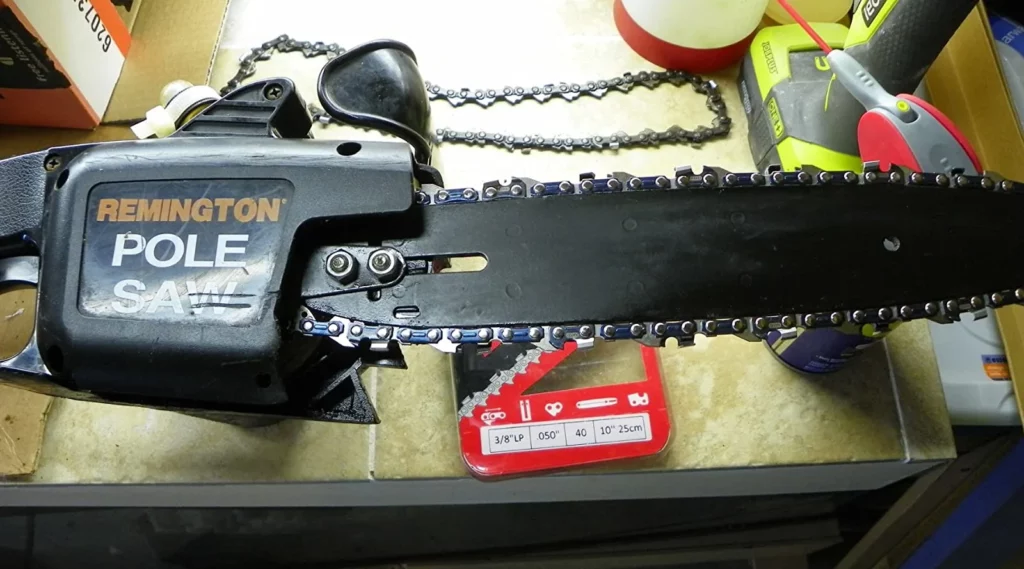
Chainsaw maintenance is essential for keeping your equipment in good working order and extending its life. Here are some tips to keep your chainsaw running smoothly.
First, check the chain tension regularly, as a loose chain can cause damage or even injury. Use a wrench to loosen the nuts and adjust the tension until it’s snug against the guide bar.
Next, clean out any debris that may have accumulated in the air filter. A dirty air filter can lead to decreased engine performance or even overheating.
It’s also important to inspect and sharpen the chain frequently. Dull blades can cause kickback or uneven cuts, so use a file guide to keep them sharp and properly aligned.
Additionally, inspect all bolts, screws, and nuts for signs of wear or damage. If anything seems loose or worn down, replace it before using your chainsaw again.
Store your chainsaw properly when not in use by keeping it clean and dry in a protective case or cover. With these simple maintenance steps, you’ll be able to extend your chainsaw’s lifespan while ensuring safe operation on every job!
Safety Tips for Special Situations
When it comes to using a chainsaw, there are certain situations that require extra caution and attention to safety. Here are some tips for staying safe in special situations:
Cutting trees on a slope: When cutting trees on a slope, always position yourself uphill from the tree so that if anything goes wrong, you won’t be in its path as it falls down the hill.
Dealing with hung-up trees: A “hung-up” tree is one that has fallen but is caught on another tree or object. These can be very dangerous because they may unexpectedly shift or fall when cut. Always use extreme caution when cutting these types of trees, and consider hiring a professional arborist to handle them.
Working in tight spaces: If you’re working in an area where maneuvering your chainsaw is difficult (such as between buildings), take extra care not to accidentally bump into anything. Use slow, deliberate movements and keep your focus on what’s around you at all times.
Cutting frozen or wet wood: Wet or frozen wood can cause your chainsaw chain to become dull more quickly than usual. Take frequent breaks to check the sharpness of your chain and replace it as needed.
Remember, no matter what situation you find yourself in while using a chainsaw, always prioritize safety above all else.
Cutting Trees On A Slope
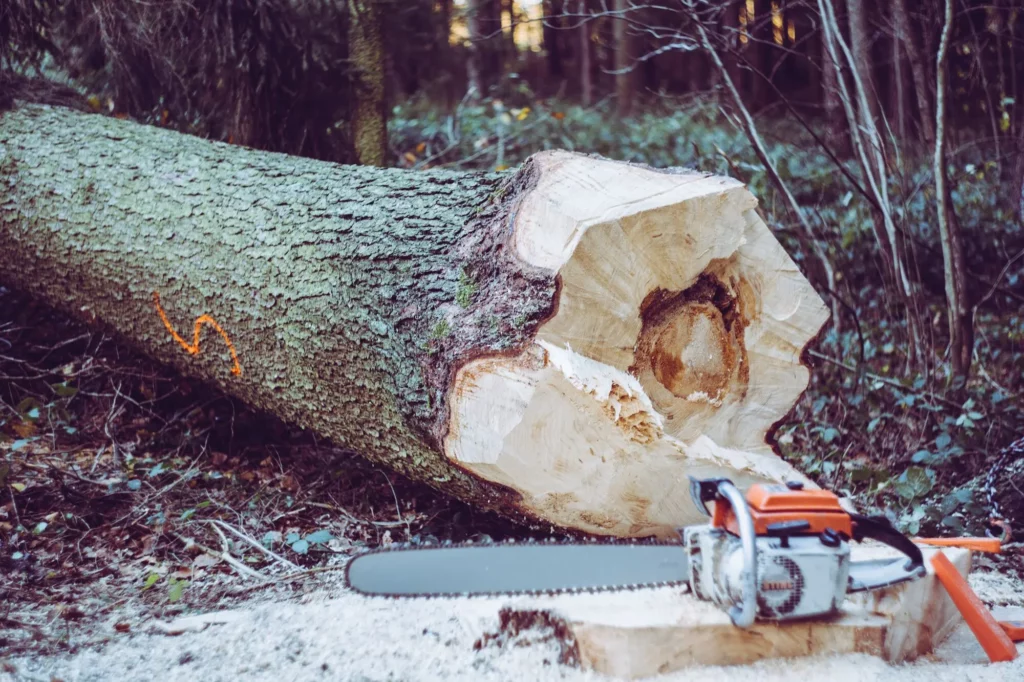
Cutting trees on a slope can be one of the most challenging tasks for chainsaw users. Before starting, it’s essential to assess the angle of the slope and determine if it is safe to work on. If you’re not confident in your ability to safely cut trees on a slope, consider hiring a professional.
If you decide to proceed with cutting trees on a slope, make sure that you have proper footing and balance. Wear sturdy boots with good traction and avoid working during rainy or icy conditions when surfaces are slippery.
When making cuts, always stand uphill from where you’re cutting so that any kickback will push you back onto the stable ground rather than down the hillside. Start by removing branches from the bottom up before making your final cut at ground level.
To prevent falling logs from rolling downhill uncontrollably, use wedges or blocking techniques such as using ropes tied around nearby trees to control their descent.
Remember that safety should always be your top priority when cutting trees on a slope. Take time to assess risks before starting work and never hesitate to call in professionals if needed.
Dealing With Hung-up Trees
Dealing with hung-up trees is one of the most dangerous situations that a chainsaw operator can encounter. A hung-up tree occurs when a felled tree becomes lodged in another standing tree or against other surrounding obstacles. The tension created by this situation can cause unpredictable movements, making it challenging to safely remove the hanging log.
In such a scenario, do not attempt to dislodge the trees with your chainsaw as it could lead to serious injury or even death. Instead, use wedges and ropes to control the fall of the wood. Always remember safety should be your top priority while dealing with hung-up trees.
Before starting work on removing a hung-up tree, assess its position and how best you can get rid of it without putting yourself at risk. Use proper personal protective equipment (PPE) like gloves and helmets before getting started.
It’s advisable always to seek help from an experienced professional who has dealt with similar scenarios before undertaking any removal activity involving hung-up trees. Remember, never compromise on safety!
Working In Tight Spaces
Working in tight spaces with a chainsaw can be quite challenging, but it’s something that many people have to do from time to time. Whether you’re trimming branches or cutting down trees, there are certain precautions and techniques you should follow when working in confined areas.
To start with, it’s important to clear the area of any obstacles or debris before beginning work. This will give you more room to move around and reduce the risk of tripping and falling while using your chainsaw.
When working in tight spaces, it’s best to use a smaller chainsaw if possible. A smaller saw is easier to maneuver and control than a larger one, which could help prevent accidents.
It’s also important to take extra care when making cuts in tight spaces. Make sure you have a clear line of sight on the cut line at all times. Take frequent breaks if necessary and always keep your blades sharp for precise cuts.
Always make sure your safety gear fits correctly before starting any job in confined areas with your chainsaw. Gloves, eye protection, and hearing protection are essential items that can help protect against injuries that may result from flying debris or loud noises during operation.
Following these tips should help ensure the safe operation of your chainsaw even when working within limited space environments!
Cutting Frozen Or Wet Wood
Cutting frozen or wet wood can be challenging, but it’s not impossible. When working with a chainsaw in these conditions, it’s important to take extra precautions to stay safe and maintain control over the tool.
Firstly, make sure that your chainsaw is equipped with a sharp chain. A dull chain will struggle even more when cutting through frozen or wet wood. You should also consider using a specialized bar oil designed for freezing temperatures.
When cutting frozen wood, try to cut parallel to the grain as much as possible. This will help prevent kickbacks and ensure a smoother cut. Additionally, if you’re dealing with larger logs that are difficult to handle on your own, consider enlisting the help of another person.
If you’re working with wet wood, keep in mind that it may harbor hidden hazards such as nails or other debris that could damage your chainsaw blade. Take extra care when making cuts and always inspect the area beforehand.
While cutting frozen or wet wood requires some extra effort and attention compared to dry material, following these tips can help ensure success while remaining safe throughout the process.
Alternative Uses For A Chainsaw
Aside from its primary use for cutting wood, a chainsaw can also be utilized for various alternative purposes. One of the most common uses is carving wooden sculptures or creating intricate designs on logs. Chainsaws with smaller blades are more appropriate for this purpose and require skilled hands to achieve precision cuts.
Another popular use of chainsaws is in the construction industry, particularly in demolition work where it can cut through concrete and metal with ease. But before using a chainsaw for these types of tasks, make sure to have proper training and safety equipment as they may pose significant hazards.
Farmers and ranchers also find value in using chainsaws to clear overgrown brush or remove unwanted trees that interfere with their livestock operations. Chainsaws are ideal tools when it comes to maintaining large plots of land.
Some people even use chainsaws as part of their art installations or performances. This unconventional use requires creativity and practice but can result in unique pieces that challenge traditional notions of art.
While primarily used for cutting wood, a versatile tool like the chainsaw has many other applications beyond what we typically think about. With proper training and safety measures taken into account, one can explore different ways to utilize this powerful tool effectively.
Chainsaw Accessories and Add-Ons
Chainsaw accessories and add-ons can enhance the performance and functionality of your chainsaw. One popular accessory is a chainsaw case or bag for easy storage and transport. Another useful addition is an extra Chainsaw Chain, which allows you to replace a dull one quickly without stopping work.
A chainsaw sharpener tool should also be considered an essential accessory, as it keeps the chain in good condition for efficient cutting. A depth gauge ensures that the teeth are filed evenly, while a file guide helps sharpen each tooth to the same angle.
Other handy additions include fuel stabilizers that keep gasoline fresh during long periods of storage, bar oilers that lubricate the chain effectively during use, and anti-vibration gloves that reduce hand fatigue when using powerful models.
Some users may prefer specialized bars with longer lengths or narrower tips for precise cuts. Additional features such as automatic oiling systems or safety switches are also available depending on your needs. With so many options available, there are plenty of ways to customize your chainsaw for optimal performance and comfort.
Chainsaw Etiquette and Ethics
When using a chainsaw, it’s important to not only focus on safety and technique but also on etiquette and ethics. Proper chainsaw etiquette helps ensure that you’re being respectful of others around you while minimizing any potential harm or damage caused by the use of your saw.
One key aspect of chainsaw etiquette is being mindful of noise pollution. Avoid operating your saw early in the morning or late at night when neighbors may be sleeping. Additionally, try to keep noise levels down by using mufflers or other sound-dampening equipment.
Another important consideration is the environmental impact. Only cut trees when necessary and make sure to dispose of waste properly. Always follow local regulations for tree removal, as many areas have specific rules regarding which trees can be cut down and how they should be disposed of.
Always treat your fellow professionals with respect and courtesy. When working alongside others who are cutting trees or performing related tasks, communicate effectively to avoid accidents and work together safely.
Conclusion
As we wrap up our ultimate guide to using a chainsaw, it’s important to remember that this powerful tool should always be handled with the utmost care and respect. Whether you’re an experienced user or just starting out, safety should always be your top priority.
By understanding the anatomy of a chainsaw and how it works, including its various safety features, you’ll be better equipped to handle any cutting job that comes your way. From basic techniques like cross-cutting and ripping to advanced methods for dealing with special situations like hung-up trees or working in tight spaces, there are many different strategies at your disposal.
But as with any tool or piece of equipment, proper maintenance is key to ensuring that your chainsaw operates smoothly and safely over time. By cleaning and sharpening the chain regularly, checking the oil levels before each use, and storing it properly when not in use, you can help extend the life of your saw while also reducing the risk of accidents.
So whether you’re planning on chopping firewood for winter or clearing brush from around your property line, make sure that you take all necessary precautions before firing up that engine. With the right knowledge and preparation under your belt, using a chainsaw can be both safe and effective – allowing you to tackle even the toughest cutting jobs with confidence!
FAQs
Can I cut metal with a chainsaw?
No, you cannot cut metal with a standard chainsaw as it is designed to work on wood only.
How often should I sharpen my chainsaw chain?
You should sharpen your chainsaw chain every time you refuel the saw or at least after every 5 hours of use.
Should I wear gloves while operating a chainsaw?
Yes, wearing gloves is highly recommended for added protection and grip while using a chainsaw.
Is there any specific fuel that I need to use for my chainsaw?
Yes, always refer to the manufacturer’s instructions regarding the type of fuel and oil mixture that your particular model requires.
Can anyone operate a chainsaw or are there age restrictions?
There may be legal age restrictions in different regions or countries when it comes to operating a powered tool like a chainsaw. Always check local regulations before allowing anyone under legal age to operate one.
